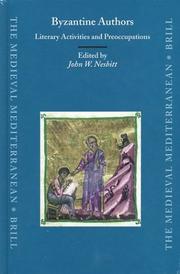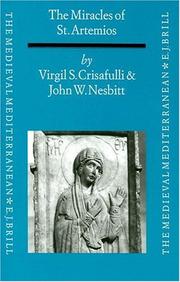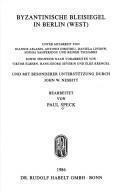| Listing 1 - 10 of 11 | << page >> |
Sort by
|

ISSN: 09285520 ISBN: 9004129758 9786610467266 1423712064 1280467266 9047402014 9789004129757 9781423712060 9781280467264 6610467269 9789047402015 Year: 2003 Volume: v. 49 Publisher: Leiden Brill
Abstract | Keywords | Export | Availability | Bookmark
 Loading...
Loading...Choose an application
- Reference Manager
- EndNote
- RefWorks (Direct export to RefWorks)
In honouring the memory of Nicolas Oikonomides, the contributors to this work offer a group of Greek texts and translations which reflect the wide interests of Byzantine authors and the varied genres to which they devoted their talents. It includes the military speeches of Constantine VII.
Byzantine prose literature --- Byzantine prose literature. --- History of Greece --- Classical Greek literature --- anno 500-1499 --- Authors, Byzantine --- Prose byzantine --- Ecrivains byzantins --- Translations into English --- Traductions anglaises --- Byzantine literature --- Byzantine prose literature - Translations into English
Book
Abstract | Keywords | Export | Availability | Bookmark
 Loading...
Loading...Choose an application
- Reference Manager
- EndNote
- RefWorks (Direct export to RefWorks)
Book
Year: 1991 Publisher: Washington Dumbarton Oaks Research Library and Collection
Abstract | Keywords | Export | Availability | Bookmark
 Loading...
Loading...Choose an application
- Reference Manager
- EndNote
- RefWorks (Direct export to RefWorks)
Book
ISSN: 09285520 ISBN: 9789004418943 9004418946 9004419403 9789004419407 Year: 2020 Volume: 120 Publisher: Leiden, The Netherlands ; Boston : Brill,
Abstract | Keywords | Export | Availability | Bookmark
 Loading...
Loading...Choose an application
- Reference Manager
- EndNote
- RefWorks (Direct export to RefWorks)
"The years before and after the battle of Manzikert (1071) mark a turning point in the history of the Byzantine Empire. The invasions of the Seljuk Turks in the east and the encroachment of the Normans from the west altered the balance of power in the eastern Mediterranean and forced the Byzantines to confront new threats to their survival. These threats came at a time when internal rivalries made an effective military response all but impossible and led to a significant transformation of the Byzantine polity under the Komnenoi. The Continuation of the Chronicle of John Skylitzes, now translated for the first time, provides a contemporary view of these troubled times. An extension of the principal source for the middle Byzantine period, and a subtle reworking of the History of Michael Attaleiates, the Continuation offers a high court official's narrative of the events and personages that shaped the course of Byzantine history on the eve of the Crusades.".
Byzantine Empire --- History y 1025-1081 --- Kings and rulers --- Byzantium (Empire) --- Vizantii︠a︡ --- Bajo Imperio --- Bizancjum --- Byzantinē Autokratoria --- Vyzantinon Kratos --- Vyzantinē Autokratoria --- Impero bizantino --- Bizantia --- History --- Kings and rulers. --- Byzantine Empire - Early works to 1800 --- Byzantine Empire - History y 1025-1081 --- Byzantine Empire - Kings and rulers
Book
ISBN: 0801470765 0801470773 9780801470776 9780801451355 0801451353 Year: 2014 Publisher: Ithaca, NY
Abstract | Keywords | Export | Availability | Bookmark
 Loading...
Loading...Choose an application
- Reference Manager
- EndNote
- RefWorks (Direct export to RefWorks)
Leprosy has afflicted humans for thousands of years. It wasn't until the twelfth century, however, that the dreaded disease entered the collective psyche of Western society, thanks to a frightening epidemic that ravaged Catholic Europe. The Church responded by constructing charitable institutions called leprosariums to treat the rapidly expanding number of victims. As important as these events were, Timothy Miller and John Nesbitt remind us that the history of leprosy in the West is incomplete without also considering the Byzantine Empire, which confronted leprosy and its effects well before the Latin West. In Walking Corpses, they offer the first account of medieval leprosy that integrates the history of East and West.In their informative and engaging account, Miller and Nesbitt challenge a number of misperceptions and myths about medieval attitudes toward leprosy (known today as Hansen's disease). They argue that ethical writings from the Byzantine world and from Catholic Europe never branded leprosy as punishment for sin; rather, theologians and moralists saw the disease as a mark of God's favor on those chosen for heaven. The stimulus to ban lepers from society and ultimately to persecute them came not from Christian influence but from Germanic customary law. Leprosariums were not prisons to punish lepers but were centers of care to offer them support; some even provided both male and female residents the opportunity to govern their own communities under a form of written constitution. Informed by recent bioarchaeological research that has vastly expanded knowledge of the disease and its treatment by medieval society, Walking Corpses also includes three key Greek texts regarding leprosy (one of which has never been translated into English before).
Leprosy --- Hansen disease --- Hanseniasis --- Hansen's disease --- Mycobacterial diseases --- History --- History, Medieval --- History of Medicine, Medieval --- History of Medicine, Renaissance --- Medicine, Medieval History --- Medicine, Renaissance --- Medieval History (Medicine) --- Renaissance Medicine --- Medieval History --- Histories, Medieval (Medicine) --- History Medicine, Medieval --- History, Medieval (Medicine) --- Medieval Histories (Medicine) --- Medieval History Medicine --- history --- Byzantium. --- Europe. --- Northern Europe --- Southern Europe --- Western Europe --- Byzantine Empire --- Leprosy - Byzantine Empire - History - To 1500 --- Leprosy - Europe - History - To 1500 --- Lépreux
Book
Abstract | Keywords | Export | Availability | Bookmark
 Loading...
Loading...Choose an application
- Reference Manager
- EndNote
- RefWorks (Direct export to RefWorks)
Book
Year: 1988 Publisher: New York (N.Y.) Ariadne galleries
Abstract | Keywords | Export | Availability | Bookmark
 Loading...
Loading...Choose an application
- Reference Manager
- EndNote
- RefWorks (Direct export to RefWorks)

ISBN: 9004105743 9789004105744 9789004476943 9004476946 Year: 1996 Volume: v. 13 Publisher: Leiden; Boston : BRILL
Abstract | Keywords | Export | Availability | Bookmark
 Loading...
Loading...Choose an application
- Reference Manager
- EndNote
- RefWorks (Direct export to RefWorks)
This volume contains a general introduction, English translation of and philological-historical commentary on an anonymous 7th- century A.D. hagiographical text entitled: An Account of the Miracles of the Holy and Glorious Megalomartyr and Wonder-worker Artemios. Also included is a photographic reproduction of the Greek text edited by A. Papadopoulos-Kerameus originally published by the Russian Academy as well as a supplementary essay by John Haldon. The general introduction discusses the historical persona of St. Artemios whose healing activities are predominantly centered on the Church of St. John Prodromos in Constantinople and who "specializes" in healing hernias and diseases affecting the genitals of mostly male patients. This book will interest students of Greek (especially Byzantine) philology, history, hagiography and medicine. As it contains a translation of the original Byzantine Greek text, it should also appeal to those seeking to improve their knowledge of Byzantine Greek.
Miracles --- Christian martyrs --- Christian saints --- Spiritual healing --- Martyrs chrétiens --- Saints chrétiens --- Guérison par la foi --- History of doctrines --- Sources. --- Biography. --- History. --- Histoire des doctrines --- Sources --- Biographie --- Histoire --- Artemios, --- Byzantine Empire --- Egypt --- Empire byzantin --- Egypte --- Church history. --- Histoire religieuse --- 235.3*23 --- -Christian martyrs --- -Christian saints --- -Miracles --- -God --- Marvelous, The --- Miracle workers --- Supernatural --- Saints --- Canonization --- Martyrs --- Martyrdom --- Divine healing --- Faith-cure --- Faith healing --- Spiritual therapies --- Healing --- Hagiografie: miracula --- History --- Biography --- -Christianity --- Religious aspects --- Artemios Saint --- -Egypt --- Church history --- -Hagiografie: miracula --- -Artemios Saint --- 235.3*23 Hagiografie: miracula --- -235.3*23 Hagiografie: miracula --- God --- -Religious aspects --- Christianity --- Martyrs chrétiens --- Saints chrétiens --- Guérison par la foi --- Christian martyrs. --- Christian saints. --- Hernia --- Legende. --- Mental Healing --- Miracles. --- Quelle. --- Spiritual healing. --- Testicular Diseases --- Wonderen. --- Wunder. --- Wunderheilung. --- Therapy. --- Biographies --- Artèmius, --- Diēgēsis tōn thaumatōn tu hagiu kai endoxu megalomartyros kai thaumaturgu Artemiu. --- 600-1500. --- Byzantine Empire. --- Egypt. --- Égypte --- History of doctrines&delete& --- Artemius, --- Middle Ages, 600-1500 --- Artemios, - Saint, - d. 363. --- Christian saints - Egypt - Biography. --- Spiritual healing - Byzantine Empire - History. --- Middle Ages, 500-1500 --- Artemius --- Miracles - History of doctrines - Middle Ages, 600-1500 - Sources. --- Christian martyrs - Egypt - Biography.

ISBN: 3774921970 Year: 1986 Publisher: Bonn Habelt
Abstract | Keywords | Export | Availability | Bookmark
 Loading...
Loading...Choose an application
- Reference Manager
- EndNote
- RefWorks (Direct export to RefWorks)
Seals (Numismatics) --- Seals (Numismatics) --- Catalogs --- Catalogs
Book

ISBN: 1282673173 9786612673177 3110227053 9783110227055 9781282673175 3110227045 9783110227048 9783110227048 6612673176 Year: 2010 Publisher: Berlin Boston
Abstract | Keywords | Export | Availability | Bookmark
 Loading...
Loading...Choose an application
- Reference Manager
- EndNote
- RefWorks (Direct export to RefWorks)
For several years now, sigillography as an independent subarea in the field of Byzantine studies has received increasing attention from both Byzantine studies and related disciplines, as it is the only area still able to provide academia with large amounts of material not previously analysed. The articles of Studies in Byzantine Sigillography deal with all aspects of Byzantine sigillography: presentation of new finds, discussion of new methods, questions of the political and ecclesiastical administration of Byzantium, prosopography, historical geography, and art-historical and iconographical p
Seals (Numismatics) --- Numismatics --- Sigillography --- Signets --- Sphragistics --- Diplomatics --- Glyptics --- Heraldry --- History --- Inscriptions --- Intaglios --- Emblems, National --- Signatures (Writing) --- Auxiliary sciences of history --- Byzantine Empire. --- Sigillography.
| Listing 1 - 10 of 11 | << page >> |
Sort by
|

 Search
Search Feedback
Feedback About UniCat
About UniCat  Help
Help News
News